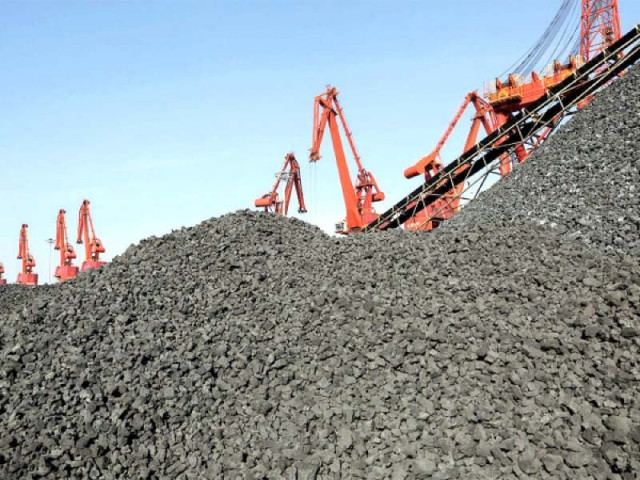Govt to revisit coal pricing formula
Plans to remove dollar indexation for rate of return

The Pakistan Tehreek-e-Insaf (PTI) government is set to renegotiate the existing coal pricing formula with the government of Sindh to remove dollar indexation for the rate of return.
In this regard, the federal government has planned to amend the Renewable Energy Policy 2019.
After renegotiation with the government of Sindh, the federal government wants to link Thar coal pricing with the rupee value. The federal government is likely to table the matter in the Council of Common Interests (CCI).
Sources told The Express Tribune that the federal government did not want more coal-based power plants in the near future either due to policy or lack of bankability. Therefore, it wants to convert the already commissioned and under-construction power plants to Thar coal.
It said that 5,500MW imported coal-based IPPs and Jamshoro-I project would be converted to Thar coal, with supplies coming from the existing blocks 1 and 2.
There will be potential consumer tariff savings through “economies of scale”. The government is targeting delivered coal price of $30 per ton vis-à-vis $50-60 per ton, which will result in foreign exchange savings.
New renewable energy capacity
Alongside taking out the unused oil-based IPP capacity, all new wind and solar IPPs will be auctioned under the hybrid (ie wind and solar in the same location) model.
Aggregate dispatch factor of 45-50% will comprise around 20% for solar and 30% for wind on an individual basis at the least-cost principle. There will be a model of “MWh added for MWh displaced” ie net zero addition while the government deals with excess capacity issue.
The government also plans block auctions to commence with the existing holders of Category-III LOIs (100+ parties, 6000+MW).
Prior action
The government also wants to amend the Alternative and Renewable Energy (ARE) Policy 2019, already approved by the CCI, in a bid to include hydropower in renewable energy as well.
Objective
Following these actions, the government will be able to achieve a more realistic, affordable and dependable path to 60% clean energy target by 2030 on a least-cost generation basis and subject to demand/supply needs as per the Indicative Generation Capacity Expansion Plan (IGCEP) model.
At present, the share of renewable energy is 4%, which is the lowest. The government wants to increase this share in coming years in order to improve the energy mix. This will help reduce the energy cost and make electricity affordable for the consumers.
Repayment to CPEC lenders
At present, the energy chain is plagued the circular debt that stands at Rs2.3 billion. It is expected to touch the Rs2.5 billion mark by end of June this year. Therefore, it is also a big challenge for the government.
During the next three years, the government is also to pay $2.8 billion (Rs435 billion) debt principle amount to the China-Pakistan Economic Corridor (CPEC) lenders. It will also affect the electricity consumers as it would result in hike in electricity rates by Rs1.5 per unit.
Rollover debt principle amount
The government has planned to request the Chinese state to fund this Rs435 billion ($2.8 billion) liability from the CPEC “dry powder” to pay off their banks as per schedule for next three years.
Meanwhile, the government will repay the amount later through the National Electric Power Regulatory Authority (Nepra) approved corresponding consumers tariff increase in 11-13 years.
GST, other taxes rationalisation
GST billed by IPPs is Rs117 billion whereas the amount on account of GST billed to consumers stands at Rs202 billion. Meanwhile, excess GST paid to Federal Board of Revenue (FBR) amounts to Rs85 billion. Its impact on consumer tariff amounts to Rs0.85 per unit.
IPPs’ fuel charges with taxes amount to Rs383 billion and it comes to Rs361 billion without taxes. The impact of taxes and duties is Rs22 billion and its impact on consumer tariff is Rs0.22 per unit. By implementing all these measures, government wants to reduce electricity rates, which are higher at present. If these rates continue rising, this will be a setback to the PTI government in the next elections.
The PTI government has already increased electricity rates several times, which had invited strong criticism. The new faces in government have now proposed these measures to Prime Minister Imran Khan to follow in a bid to reduce electricity rates.
Even, if China agrees to extend principle debt for the next three years, it will be a problem for the next government.
Published in The Express Tribune, May 12th, 2021.
Like Business on Facebook, follow @TribuneBiz on Twitter to stay informed and join in the conversation.



















COMMENTS
Comments are moderated and generally will be posted if they are on-topic and not abusive.
For more information, please see our Comments FAQ